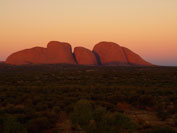
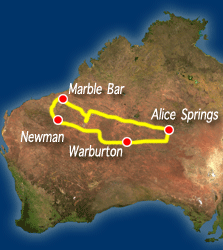
Diamantina Touring Commpany strongly believe in the value of travel insurance. You can purchase NIB Insurance (Australia Limited) policies issued via the link below. You can use this link to purchase travel insurance not only for Diamantina expeditions, but for any travel you want to do anywhere in the world. This insurance is underwritten by XL Insurance Company SE, Australia branch (ABN 36 083 570 441) A Product Disclosure Statement should be considered before acquiring this product..
When crafting this expedition, our aim was to encapsulate the true essence of the Western Deserts, showcasing their remarkable diversity. From the rugged peaks of the secluded Karlamilyi (Rudall River) National Park to the striking red ironstone ranges of the lesser-known East Pilbara, and onwards to the botanical marvels of the Gibson Desert bio-region. This vast expanse represents one of Australia's last true wilderness areas, with vehicle tracks only penetrating its depths in the 1960s. Terry Long, the Woomera Native Patrol officer of that time, aptly described the mystery, stating, “No one had been out there. The desert, as far as the Department [WA Dept of Supply] was concerned... was an unknown, as it was to the whole of Western Australia. The Warburton Ranges [were] as far as anybody got. People in those days knew absolutely nothing about Aborigines.”
Our journey delves into the geological history of the East Pilbara, offering a window into the depths of time, providing glimpses of a world as it existed 3.5 billion years ago. This expedition invites you to explore these remote and stunning locations at a leisurely pace. While the four-wheel driving is not overly challenging, the beauty and isolation of these areas are bound to leave a lasting impression.
This year is our final year before retirement, and this is the final opportunity to experience this astonishing country. The expedition will be personally led by Andrew Dwyer.

In 1971 the late Geoffrey Bardon arrived at Papunya in his combi van to teach art. Under his tutelage the artists translated the images they once painted on sand and rock into canvass images .These images represent the Tjukurpa (dreaming) and are an extension of ceremonial expression. Papunya Tula Artists are spread right across the Western Deserts in places like Kiwirrkurra, Haasts Bluff and Kintore. Different areas have developed different styles, the movement is constantly developing.

Karlamilyi (Rudall River) National Park is the second largest National Park in Australia after Kakadu. It is 1.3 million hectares in size and contains the complete watershed of the Rudall River, from its beginning to its terminal sump at the salt Lake Dora. An extraordinary rugged and remote place. And the Desert Queen Baths are a great swim!

Until recently East Pilbara Shire, at 380,000 sq. km was the largest shire in the world. Alas no longer, pipped to the post by the creation of Qaasuitsup and Sermersooq shires in Greenland. No matter, its still bloody big!
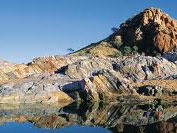
They reckon there are a lot of nongs who arrive at the Cast Iron Pub in Marble Bar looking for a bar made of marble. The Marble Bar is a seam of jasper outside town that runs across the bed of the Coongan River. The bar in the pub is made of timber, but its still a good place to get a refreshment, and the first watering hole since Alice Springs.
From Alice Springs we head along Larapinta Drive through the Western MacDonnell Ranges to Glen Helen, where the Finke River cuts a spectacular gorge through the range. We travel to the community of Haasts Bluff, home to Luritja and some Pintubi people. The Ikuntji Art Centre has developed over the past few years into a vibrant and productive project. Further on at the foot of Haasts Bluff is a memorial to Frederick Blakeley, an explorer and prospector of the early 1900's whose primary claim to fame was that his favoured means of transport in the outback was the bicycle, which he considered to be superior to the horse. We then head to the Papunya Tjipi art center at Papunya. We camp in view of the magnificent massif of Mt. Liebig, at 5000’ one of the highest peaks in Central Australia.
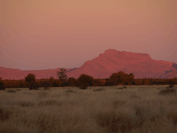
Our first morning back in the outback. Awake to birdsong, and after breakfast head off for a walk while we pack the vehicles. We head west along the Gary Junction Road, originally built by Len Beadell as part of the Woomera long distance weapons project. Len constructed the road between August and November 1960. The road is maintained in good condition and travels along spectacular country interspersed with dramatic ranges. We visit Sandy Blight Junction and continue on past the Western Australian border and take an early camp at the scenic Dovers Hills.
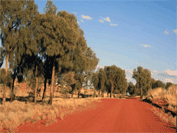
We travel on to Kiwirrkurra. Considered the most remote Aboriginal community in Australia, Kiwirrkurra is home to the Pintubi people. We visit the Women’s Centre and the Art Centre, where Papunya Tula artists work. We also visit Len Beadell's burned out mess truck and the community store. We continue along the track west, where the Acacia woodland begins to give way to the sandhills of the Great Sandy Desert.

The road continues west through expansive country, vast Spinifex plains interspersed with patches of acacia woodland, and stands of flowering grevillea. We enter an extensive desert oak forest, and visit Jupiter Well. There is a Beadell marker at Gary Junction, after signing the visitors book we take the Jenkins Track through to the Canning Stock Route. We take on water at Well 33, the birthplace of Rover Thomas. At Kunawarritji Aboriginal Community there is a shower, and the chance to purchase limited items at the shop while taking in the ambience of this remote western desert community. We continue west and camp near the banks of Lake Auld at Burrow Bore.
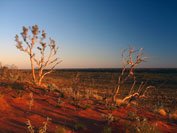
We travel to the community of Punmu, situated curiously on the shore of the saline Lake Dora. Almost reminiscent of a seaside town, other than the fact there is no water and we are in the middle of the Great Sandy Desert! We continue on to lunch on an unnamed high knoll with spectacular views over the surrounding desert. We pass by the Telfer Mine. This is a huge project , the largest gold mine in Australia operated by Newcrest involving two open cut and one underground mine. The gold is processed on site and the gold copper concentrate is trucked to Port Headland to be shipped, mainly to East Asia. That would mean the roads ahead improve – but not for us, we are heading south towards the remote and spectacular Karlamilyi (Rudall River) National Park. The sandhills finally recede, and we enter the Throssel Range. We visit breakfast creek waterhole and view Aboriginal petroglyphs and the carved names of early explorers. We take a break at the Duck Pond, a beautiful water filled gorge on the Coolbro Creek and continue on to our camp on an unnamed claypan surrounded by Spinifex coated red rocky ranges punctuated with white gums. This will be our base for the next two nights.
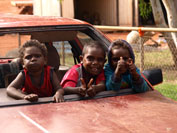
There is more stunning rangeland as the track winds south. We stop at an abandoned exploration camp replete with a hand pump for extracting crystal clear drinking water, and shortly after enter Karlamilyi National Park. Its name was changed in 2008 from Rudall River National Park to formally acknowledge the traditional owners. At 1,283,706 hectares it is largest National Park in Western Australia, and two and a half time the size of the Grand Canyon National Park in Arizona, but due to its remoteness it receives little visitation. We travel past the singular Compton Pinnacle, slowly picking our way across creek lines and washaways down to the Desert Queen Baths, a steep gorge punctuated with a series of waterholes. We explore the gorge, including Aboriginal paintings and petroglyphs, and those who don’t mind cold water can take a dip in one of the bracing pools. In the late afternoon we return to camp.
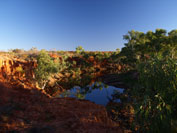
We retrace our drive north for around 30 kms to a round dome like hill named Moses Chair by the explorer Frank Hann, before turning north west onto a seldom travelled access track through the western- most sandhills of the Great Sandy Desert. We travel through the Nifty Copper mine and on to the Woodie Woodie Mine, which marks our entry into the East Pilbara. 700 people, mainly fly in fly out, live and work here. Operated by Consolidated Minerals, which was the subject of a hostile takeover by Ukrainian billionaire Gennadiy Bogolyubov, the mine extracts high quality Manganese mainly for use in stainless steel production. It appears out of nowhere, and thankfully disappears in the rear vision mirror equally as quickly, the main advantage being the road improves beyond Woodie. We take a lunch break beneath giant melaleucas and river red gums at a waterhole in the Oakover River. Ringed by giant Melaleuca trees, this waterhole is one of the most beautiful in the outback. The afternoon is spent enjoying one of the more remote and less visited parts of the East Pilbara. We explore the magnificent Upper Carrwine Gorge.
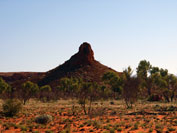
After breakfast we head to Running Waters for a morning swim in one of the outback’s most delightful swimming holes. Surrounded by huge trees and tangled roots, the warm crystal clear spring fed water is a delight. We take the Skull Springs road through spectacular ranges redolent of a Fred Williams painting to Nullagaine and then north to Marble Bar, famous as Australia’s hottest town. No visit to Marble Bar would be complete without dropping in to the Iron Clad Hotel, a corrugated iron pub now on the Western Australian State heritage register. Our camp is at Doolena Gorge, amongst white gums beside the Coogan River.
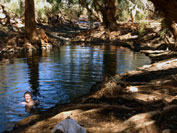
We return to Marble Bar and visit the museum before heading out to the fabled "Bar", a reef of striped red white and blue Jasper that forms a bar on the Coongan River. We travel along the Hillside Track geological trail, visiting Glen Herring Gorge. We camp amidst stunning Granite Tors. This is our most north westerly camp.

We travel south along the Port Headland road to the Auski Roadhouse. A chance to freshen up at the Caravan Park in Newman, visit the delightful Newman shopping Mall, where one can enjoy Newman café society while we reprovision for the next leg of our adventure. We refuel alongside the Road Trains at the Capricorn Roadhouse, one of Australia’s busiest, before heading to our camp in Acacia woodland north of Newman.

Our arrival at a Len Beadell marker signifies our return to the Great Sandy Desert, this time, east along the Talawana Track. We cross the tributary of the Oakover River and the original Rabbit Proof Fence. We fuel up at Parngurr community ahd travel to Georgia Bore on the Canning Stock Route. After topping up our water supplies from the hand pump we continue on to camp just beyond Well 23 on the Canning.
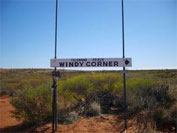
We travel for 10 kms further along the Canning Stock Route before turning east to take the path less travelled along the Talawana Track, also constructed by Len Beadell. As we leave the stock route, the country flattens out and we find ourselves in wide open vast sandhill terrain . This is truly remote, seldom travelled country, offering spectacular vistas. We visit Midway Well, a native well that provided welcome relief for Larry Wells on the ill feted Calvert Expedition in 1907. Eventually the sandhills give way to the laterite plains and acacia woodlands of the Gibson Desert.
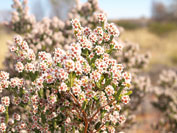
After a delightful drive through acacia woodland , mulga thickets and Spinifex grasslands we arrive at Windy Corner. No prizes for working out why Len named it such, but it is the culmination of our run along the Talawanna Track, and our junction with the Gary Highway, which will take us south to the Gunbarrel. A spectacular view of the surrounding desert is obtained from the summit of McDougall’s Knob. We contine south across rangeland and enter the Gibson Desert Nature Reserve. We camp at the ephemeral Lake Cohen, which when full is an important stop for migratory birds.
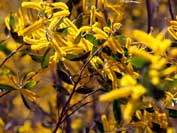
A full day in the Gibson Desert Nature Reserve. This magnificent remote and seldom visited park is an absolute delight with its mulga parkland over lateritic plains interspersed with ephemeral clay pans like Lake Cohen that provide refuge for migratory birds. There are also occasional sandstone mesas that rise up punctuating the landscape. It is a feast for the eyes.We climb McPhersons Pillar, and Mulgan Rockhole. Crossing Charlies Knob with its expansive views and curious sculptures we arrive at Everard Junction. We turn east along the legendary Gunbarrel Highway.
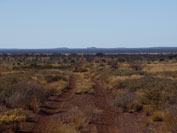
From Mt Everard we head south east to Mt. Beadell. The more athletic can hike to the summit, where a theodolite in a cage provides a memorial to Len Beadell. The track continues on past spectacular rangeland to Notabilis Hill and on to our camp on the Heather Highway.
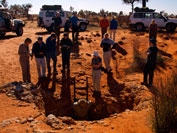
This morning we arrive in Warburton. We visit the Tjulyuru Arts Centre that contains some stunning examples of slump glasswork. Taparti Bates won a Normanby art prize with this glasswork. We visit Giles Meteorological Station and its museum. We will stop at the Warakurna Roadhouse and continue on to our camp with a view of the spectaculare Schwerin Mural Crescent, a rugged range named by Ernest Giles in 1874.

The road crosses he Northern Territory Border at Docker River. We pay a visit to Lasseter's Cave, where the fabled explorer sheltered before setting off east to his death. we travel east past the Petermann Ranges and stop on a red sandhill to view Kata Tjuta, before arriving at Yulara Ayers Rock Resort. There is the option to leave the tour here or continue north to arrive at Alice Springs Hotels early evening.
